Amundsenia is a genus of saxicolous lichens in the family Teloschistaceae. It has two species. The genus was circumscribed in 2014 by Isaac Garrido-Benavent, Ulrik Søchting, Sergio Pérez-Ortega, and Rod Seppelt, with Amundsenia austrocontinentalis assigned as the type species. The type is known only from continental Antarctica, while Amundsenia approximata only occurs in the Arctic.
Austroplaca is a genus of lichen-forming fungi in the family Teloschistaceae. It has 10 species. The genus was circumscribed in 2013 by Ulrik Søchting, Patrik Frödén, and Ulf Arup, with Austroplaca ambitiosa assigned as the type species.

Xanthocarpia is a genus of mostly crustose lichens in the family Teloschistaceae. It has 12 species with a largely Northern Hemisphere distribution.
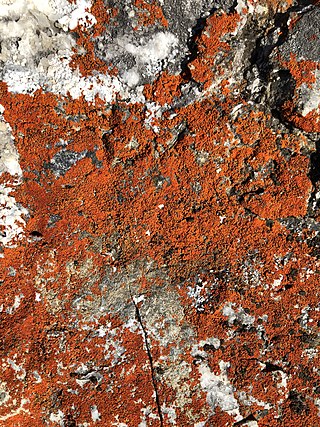
Igneoplaca is a genus in the subfamily Xanthorioideae of the family Teloschistaceae. It contains a single species, the crustose lichen Igneoplaca ignea.
Variospora aegaea is a species of saxicolous (rock-dwelling), crustose lichen in the family Teloschistaceae. First identified from Greek islands in the Aegean Sea, and has since been recorded in Italy and Spain.
Amundsenia austrocontinentalis is a species of saxicolous (rock-dwelling), crustose lichen in the family Teloschistaceae, and the type species of genus Amundsenia. Found in Antarctica, it was formally described as a new species in 2014 by Isaac Garrido-Benavent, Ulrik Søchting, Sergio Pérez-Ortega, and Rod Seppelt. The type specimen was collected by the last author from Mule Peninsula, where it was found growing on small stones in glacial till. The species epithet austrocontinentalis refers to its distribution in continental Antarctica.
Catenarina is a genus of lichen-forming fungi in the family Teloschistaceae consisting of three species. These crustose lichens are characterized by their reddish-brown pigmentation and the presence of the secondary compound 7-chlorocatenarin. The genus is found in the southernmost regions of the Southern Hemisphere, including Antarctica, southern Patagonia, and the Kerguelen Islands.
Catenarina desolata is a species of lichen in the family Teloschistaceae. It was formally described as a new species in 2014 by lichenologists Ulrik Søchting, Majbrit Søgaard, and Arve Elvebakk. It is predominantly found in the southernmost parts of Chile, with some instances in Antarctica and the Kerguelen Islands. Characterised by its dark reddish-brown to almost purple apothecia, this species of lichen was originally thought to be lichenicolous, meaning it grows on other lichens, particularly Aspicilia species. The later discovery non-lichen-dwelling examples from James Ross Island in the Antarctic Peninsula suggests that it is not exclusively lichenicolous. Its distinctive secondary compound, 7-chlorocatenarin, sets it apart from other lichens in the region.
Catenarina vivasiana is a species of crustose lichen in the family Teloschistaceae. It is found in the southernmost regions of South America, predominantly in Chile. Characterised by its dark reddish-brown thallus and unique chemistry, this lichen is named in honour of Spanish lichenologist Mercedes Vivas. It was formally described as a new species in 2014.
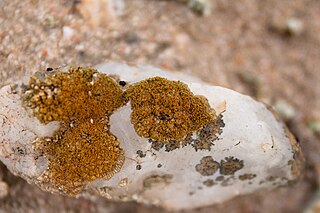
Stellarangia is a genus of lichen-forming fungi in the family Teloschistaceae. It has three species of saxicolous (rock-dwelling), crustose lichens. Species of Stellarangia are found in dry, desert areas in Namibia and South Africa.
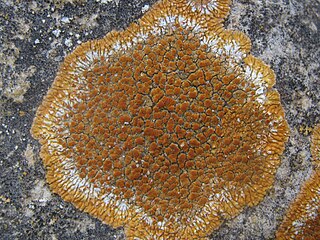
Variospora flavescens is a species of saxicolous (rock-dwelling), crustose lichen in the family Teloschistaceae. It is a common, widely distributed species and has been recorded in Africa, Asia, Europe, and Macaronesia.
Tassiloa is a genus of lichen-forming fungi in the family Teloschistaceae. It has two species.
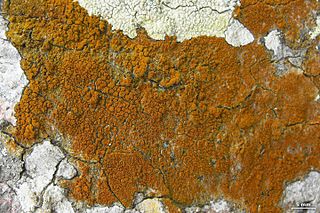
Lacrima is a genus of lichen-forming fungi in the family Teloschistaceae. It has four saxicolous (rock-dwelling), crustose species.
Teuvoahtiana is a genus of lichen-forming fungi in the family Teloschistaceae. It contains three species of saxicolous (rock-dwelling), crustose lichens, all of which occur in South America.
Caloplaca nigra is a species of saxicolous (rock-dwelling), crustose lichen in the family Teloschistaceae. Found on rocks predominantly in the Galápagos Islands, it is characterised by its dark reproductive structures.
Solitaria is a fungal genus in the family Teloschistaceae. It contains a single species, the corticolous (bark-dwelling), crustose lichen Solitaria chrysophthalma.

Erichansenia is a genus of lichen-forming fungi in the family Teloschistaceae. It has three species of saxicolous (rock-dwelling), crustose lichens.
Usnochroma is a genus of lichen-forming fungi in the family Teloschistaceae. It has two species of crustose lichens. The genus was circumscribed in 2013 by lichenologists Ulrik Søchting, Ulf Arup, and Patrik Frödén, with Usnochroma carphineum assigned as the type species. The genus name refers to the yellowish-green colour of the thallus, which is caused by the substance usnic acid. Usnochroma species occur in Macaronesia, South Africa, the Mediterranean Basin, and Algeria.
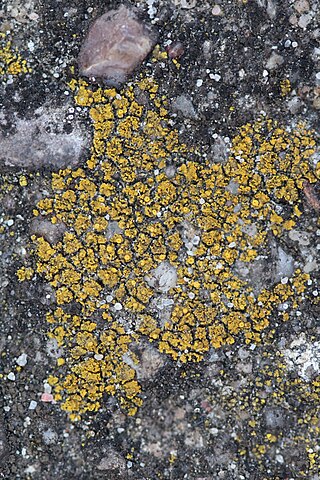
Flavoplaca arcis is a species of saxicolous (rock-dwelling), crustose to squamulose (scaley) lichen in the family Teloschistaceae. Although widely distributed in Northern, Central, and Western Europe, it is not commmonly encountered.
Upretia is a genus of lichen-forming fungi in the family Teloschistaceae. It has three species of saxicolous (rock-dwelling), crustose lichens. Upretia is characterised by its small ascospores and narrow, rod-shaped conidia. The distribution of the genus ranges from mid-altitude rocky terrains in India to both arid and higher altitudinal environments in China.






